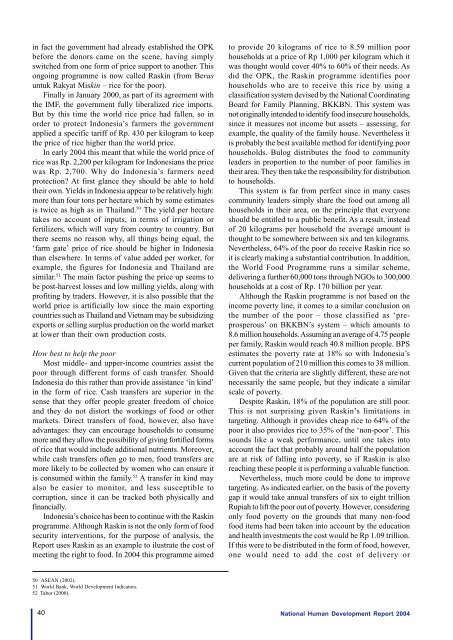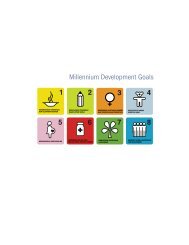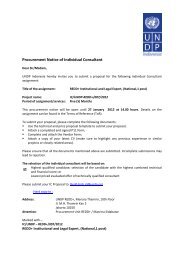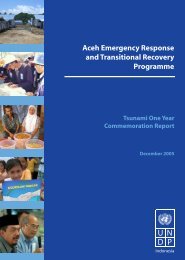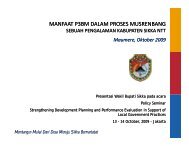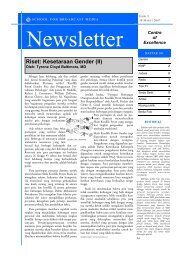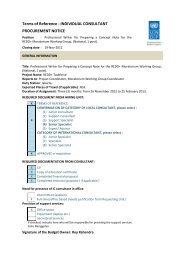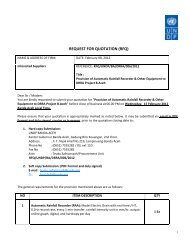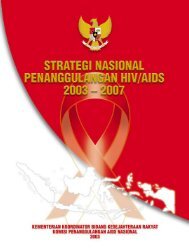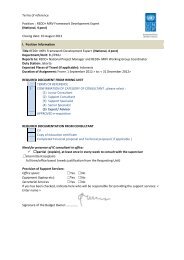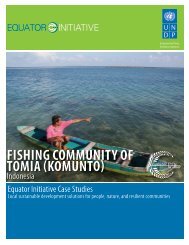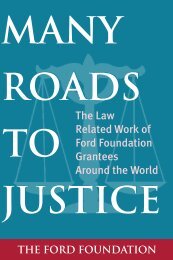in fact <strong>the</strong> government had already established <strong>the</strong> OPKbefore <strong>the</strong> donors came on <strong>the</strong> scene, having simplyswitched from one form of price support to ano<strong>the</strong>r. Thisongoing programme is now called Raskin (from Berasuntuk Rakyat Miskin – rice for <strong>the</strong> poor).Finally in January 2000, as part of its agreement with<strong>the</strong> IMF, <strong>the</strong> government fully liberalized rice imports.But by this time <strong>the</strong> world rice price had fallen, so inorder to protect <strong>Indonesia</strong>’s farmers <strong>the</strong> governmentapplied a specific tariff of Rp. 430 per kilogram to keep<strong>the</strong> price of rice higher than <strong>the</strong> world price.In early 2004 this meant that while <strong>the</strong> world price ofrice was Rp. 2,200 per kilogram for <strong>Indonesia</strong>ns <strong>the</strong> pricewas Rp. 2,700. Why do <strong>Indonesia</strong>’s farmers needprotection? At first glance <strong>the</strong>y should be able to hold<strong>the</strong>ir own. Yields in <strong>Indonesia</strong> appear to be relatively high:more than four tons per hectare which by some estimatesis twice as high as in Thailand. 50 The yield per hectaretakes no account of inputs, in terms of irrigation orfertilizers, which will vary from country to country. But<strong>the</strong>re seems no reason why, all things being equal, <strong>the</strong>‘farm gate’ price of rice should be higher in <strong>Indonesia</strong>than elsewhere. In terms of value added per worker, forexample, <strong>the</strong> figures for <strong>Indonesia</strong> and Thailand aresimilar. 51 The main factor pushing <strong>the</strong> price up seems tobe post-harvest losses and low milling yields, along withprofiting by traders. However, it is also possible that <strong>the</strong>world price is artificially low since <strong>the</strong> main exportingcountries such as Thailand and Vietnam may be subsidizingexports or selling surplus production on <strong>the</strong> world marketat lower than <strong>the</strong>ir own production costs.How best to help <strong>the</strong> poorMost middle- and upper-income countries assist <strong>the</strong>poor through different forms of cash transfer. Should<strong>Indonesia</strong> do this ra<strong>the</strong>r than provide assistance ‘in kind’in <strong>the</strong> form of rice. Cash transfers are superior in <strong>the</strong>sense that <strong>the</strong>y offer people greater freedom of choiceand <strong>the</strong>y do not distort <strong>the</strong> workings of food or o<strong>the</strong>rmarkets. Direct transfers of food, however, also haveadvantages: <strong>the</strong>y can encourage households to consumemore and <strong>the</strong>y allow <strong>the</strong> possibility of giving fortified formsof rice that would include additional nutrients. Moreover,while cash transfers often go to men, food transfers aremore likely to be collected by women who can ensure itis consumed within <strong>the</strong> family. 52 A transfer in kind mayalso be easier to monitor, and less susceptible tocorruption, since it can be tracked both physically andfinancially.<strong>Indonesia</strong>’s choice has been to continue with <strong>the</strong> Raskinprogramme. Although Raskin is not <strong>the</strong> only form of foodsecurity interventions, for <strong>the</strong> purpose of analysis, <strong>the</strong><strong>Report</strong> uses Raskin as an example to ilustrate <strong>the</strong> cost ofmeeting <strong>the</strong> right to food. In 2004 this programme aimedto provide 20 kilograms of rice to 8.59 million poorhouseholds at a price of Rp 1,000 per kilogram which itwas thought would cover 40% to 60% of <strong>the</strong>ir needs. Asdid <strong>the</strong> OPK, <strong>the</strong> Raskin programme identifies poorhouseholds who are to receive this rice by using aclassification system devised by <strong>the</strong> National CoordinatingBoard for Family Planning, BKKBN. This system wasnot originally intended to identify food insecure households,since it measures not income but assets – assessing, forexample, <strong>the</strong> quality of <strong>the</strong> family house. Never<strong>the</strong>less itis probably <strong>the</strong> best available method for identifying poorhouseholds. Bulog distributes <strong>the</strong> food to communityleaders in proportion to <strong>the</strong> number of poor families in<strong>the</strong>ir area. They <strong>the</strong>n take <strong>the</strong> responsibility for distributionto households.This system is far from perfect since in many casescommunity leaders simply share <strong>the</strong> food out among allhouseholds in <strong>the</strong>ir area, on <strong>the</strong> principle that everyoneshould be entitled to a public benefit. As a result, insteadof 20 kilograms per household <strong>the</strong> average amount isthought to be somewhere between six and ten kilograms.Never<strong>the</strong>less, 64% of <strong>the</strong> poor do receive Raskin rice soit is clearly making a substantial contribution. In addition,<strong>the</strong> World Food Programme runs a similar scheme,delivering a fur<strong>the</strong>r 60,000 tons through NGOs to 300,000households at a cost of Rp. 170 billion per year.Although <strong>the</strong> Raskin programme is not based on <strong>the</strong>income poverty line, it comes to a similar conclusion on<strong>the</strong> number of <strong>the</strong> poor – those classified as ‘preprosperous’on BKKBN’s system – which amounts to8.6 million households. Assuming an average of 4.75 peopleper family, Raskin would reach 40.8 million people. BPSestimates <strong>the</strong> poverty rate at 18% so with <strong>Indonesia</strong>’scurrent population of 210 million this comes to 38 million.Given that <strong>the</strong> criteria are slightly different, <strong>the</strong>se are notnecessarily <strong>the</strong> same people, but <strong>the</strong>y indicate a similarscale of poverty.Despite Raskin, 18% of <strong>the</strong> population are still poor.This is not surprising given Raskin’s limitations intargeting. Although it provides cheap rice to 64% of <strong>the</strong>poor it also provides rice to 35% of <strong>the</strong> ‘non-poor’. Thissounds like a weak performance, until one takes intoaccount <strong>the</strong> fact that probably around half <strong>the</strong> populationare at risk of falling into poverty, so if Raskin is alsoreaching <strong>the</strong>se people it is performing a valuable function.Never<strong>the</strong>less, much more could be done to improvetargeting. As indicated earlier, on <strong>the</strong> basis of <strong>the</strong> povertygap it would take annual transfers of six to eight trillionRupiah to lift <strong>the</strong> poor out of poverty. However, consideringonly food poverty on <strong>the</strong> grounds that many non-foodfood items had been taken into account by <strong>the</strong> educationand health investments <strong>the</strong> cost would be Rp 1.09 trillion.If this were to be distributed in <strong>the</strong> form of food, however,one would need to add <strong>the</strong> cost of delivery or50 ASEAN (2002).51 World Bank, World <strong>Development</strong> Indicators.52 Tabor (2000).40National <strong>Human</strong> <strong>Development</strong> <strong>Report</strong> 2004
administration, plus an allowance for leakages due to mistargeting.Cross-country studies reveal that for every $1spent on food distribution programmes <strong>the</strong> administrationcost varies from $1.60 to $2.00, and <strong>the</strong> average leakageis about 30%. 53 The leakage occurs not just because ofcorruption, but mainly due to difficulties associated withidentifying <strong>the</strong> poor or targeting. Thus, taking a middlefigure of Rp. 1.75 trillion for administration and allowingfor 30% mis-targeting, <strong>the</strong> total annual food security costcomes to Rp. 3.68 trillion. This figure is about Rp. 1.1trillion less than <strong>the</strong> current annual budget of Raskin,primarily because it aims to help only <strong>the</strong> 4.4% of <strong>the</strong>population falling below <strong>the</strong> food poverty line.Some of this transfer could be achieved through amore effective Raskin programme. Alternatively, it couldbe implemented by such programme as ‘food-for-work’.This kind of programme has been found very effective inBangladesh and India for example. Targeting tends to bemore effective since only <strong>the</strong> poor will be prepared to do<strong>the</strong> necessary work. This ‘self-targeting’ can be fur<strong>the</strong>renhanced by setting <strong>the</strong> food-wage rate at slightly below<strong>the</strong> market wage rate. Food-for-work programmes have<strong>the</strong> additional benefit that <strong>the</strong>y help maintain and buildrural infrastructure.Finally, not all of this need be new money. Some couldcome from <strong>the</strong> government’s existing food security budgetwhich amounts to around Rp. 4 trillion. For example, fundscould be reallocated from <strong>the</strong> fertilizers subsidies – whichare not targeted specifically at poor farmers.The overall message <strong>the</strong>refore, is that by a combinationof methods it should be quite possible to achieve foodsecurity in terms of quantity of rice – and to do so relativelyinexpensively. It may be challenging logistically, oradministratively, or politically, but <strong>the</strong> main obstacle shouldnot be cost.The cost of physical securityPhysical security or freedom from violence is afundamental human right and providing such security and<strong>the</strong> protection of <strong>the</strong> law is one of <strong>the</strong> most basic functionsof <strong>the</strong> state. Without this freedom, people not only riskserious injury and death, <strong>the</strong>y cannot go about <strong>the</strong>ir dailylives and are at risk of falling into poverty – especiallywhen families lose <strong>the</strong>ir main income earner. The areas in<strong>Indonesia</strong> most affected by violence have seen declinesin human development due to falls in both income and lifeexpectancy.In <strong>Indonesia</strong>, as elsewhere, violence takes many forms.In some cases it has been linked to ethnic and o<strong>the</strong>rstruggles, claiming <strong>the</strong> lives of many people and displacingthousands of o<strong>the</strong>rs. But many parts of <strong>the</strong> country haveseen increases in violent crimes: muggings, robberies andphysical abuse or attacks. In Jakarta, for example,according to <strong>the</strong> Chief of Police, a crime occurs every 15minutes and 33 seconds. 54 Crimes involving explosivesrose from 95 in 2001 to 114 in 2002.<strong>Indonesia</strong> has also been a victims of <strong>the</strong> rise in globalterrorism. This has included a number of bomb attacks:at <strong>the</strong> Istiqlal mosque, several churches, shopping malls,<strong>the</strong> Philippine Ambassador’s residence and <strong>the</strong> Marriothotel, but <strong>the</strong> largest loss of life arose from <strong>the</strong> bomb inBali in 2002 that killed 202 people.Guaranteeing physical security requires <strong>the</strong>maintenance of law and order and <strong>the</strong> prosecution ofperpetrators. But such protection need not take placeentirely through <strong>the</strong> police and <strong>the</strong> judicial system. Activeparticipation from institutions of civil society can alsoprevent social conflicts from erupting into destructiveviolence. And at <strong>the</strong> community level evidence from manycountries also shows that civic engagement throughneighbourhood watch can play an important role inpreventing crime. 55Reform of <strong>the</strong> security apparatusIn <strong>Indonesia</strong> until recently <strong>the</strong>re was little distinctionbetween internal and external security – between <strong>the</strong> policeand <strong>the</strong> army. The police force was part of <strong>the</strong> nationaldefence department and under <strong>the</strong> command of <strong>the</strong> army,<strong>the</strong> Tentara Nasional <strong>Indonesia</strong> (TNI). The TNI saw itselfas <strong>the</strong> guardian of <strong>the</strong> nation. However, <strong>the</strong> TNI’s imagewas seriously tarnished during <strong>the</strong> reign of PresidentSoeharto who used it to consolidate his power – startingwith <strong>the</strong> annihilation of millions of civilians in <strong>the</strong> earlyphase of <strong>the</strong> New Order administration. The TNI alsohad a direct involvement in politics. It claimed a dualfunction, dwi-fungsi, taking both a military and a socialrole which included representation in <strong>the</strong> upper house ofparliament, <strong>the</strong> MPR. The TNI’s image as a neutralguardian of law and order was fur<strong>the</strong>r damaged by itsactivities in conflict-prone regions such as Aceh, Papuaand East Timor. The poor image of <strong>the</strong> TNI also tarnishedpublic perceptions of <strong>the</strong> police force. Indeed since <strong>the</strong>TNI was often involved in various ‘police actions’ <strong>the</strong>role of <strong>the</strong> police force itself was not clear.Following <strong>the</strong> collapse of <strong>the</strong> New Order <strong>the</strong>re havebeen a number of important reforms, through constitutionalamendments that have changed <strong>the</strong> roles of <strong>the</strong> TNI and<strong>the</strong> police force. One of <strong>the</strong> most important is that <strong>the</strong>TNI has relinquished its political role and its membershipof MPR. In addition in January 2001, <strong>the</strong> police force(POLRI) and <strong>the</strong> TNI were separated, with POLRI beingplaced under <strong>the</strong> direct command of <strong>the</strong> President. Now<strong>the</strong> TNI is entrusted with <strong>the</strong> traditional role of nationaldefence against external threats while POLRI is solelyresponsible for internal security.53 Subbarao, et. al. (1997).54 The Jakarta Post, February 22, 2003.55 Feltes (2000) refers to community-police partnership as a new approach to crime prevention. According to him, public opinion and informal social control have <strong>the</strong> central rolenot only in defining what crime is, but also in maintaining social order. Thus, partnerships between police and community, governments and citizens, institutions andindividuals focus on prevention and <strong>the</strong> combination of social activities, and constitute a new philosophy of policing.National <strong>Human</strong> <strong>Development</strong> <strong>Report</strong> 2004 41
- Page 2 and 3: NationalHuman DevelopmentReport 200
- Page 4 and 5: ForewordIndonesia has made critical
- Page 6 and 7: AcknowledgementsThis Report is a re
- Page 8: AbbreviationsAPBDAPBNASEANBAPPENASB
- Page 11 and 12: TABLES2.1 - Comparison of per capit
- Page 13 and 14: EXECUTIVE SUMMARYIndonesiaNational
- Page 15 and 16: to meet the Millennium Development
- Page 17 and 18: Chapter 1Indonesia in transition:To
- Page 19 and 20: The place of human development in I
- Page 21 and 22: Chapter 2The state of human develop
- Page 23 and 24: Figure 2.4 - Map of human developme
- Page 25 and 26: Figure 2.4 - Social indicators, 197
- Page 27 and 28: of income and corporate taxes has r
- Page 29 and 30: Figure 2.10 - GDP growth, 1990-2003
- Page 31 and 32: Table 2.4 - Proportion of total bri
- Page 33 and 34: In addition, the overall sense of p
- Page 35 and 36: themselves. On this basis Indonesia
- Page 37 and 38: Box 3.2 - Pathways to human develop
- Page 39 and 40: Table 3.3 - Infant mortality rate a
- Page 41 and 42: poor is a clear recognition that de
- Page 43 and 44: educing the infant mortality rate m
- Page 45 and 46: assuming that 1.3 trillion would co
- Page 47 and 48: The national figure would certainly
- Page 49 and 50: expenditure. In practice, it would
- Page 51: Table 4.2 - Provincial breakdown of
- Page 55 and 56: Figure 4.5 - Ratio of salaries of p
- Page 57 and 58: Appendix to Chapter 4Health and edu
- Page 59 and 60: The third is the ‘Special Fund’
- Page 61 and 62: Chapter 5Rethinking fiscal prioriti
- Page 63 and 64: At the very outset, however, it sho
- Page 65 and 66: enforcement particularly for person
- Page 67 and 68: Another risk from decentralization
- Page 69 and 70: Box 5.2 - Variations in poverty con
- Page 71 and 72: physical security - which contribut
- Page 73 and 74: centre, for example, played a signi
- Page 75 and 76: BibliographyAbidin, A. (2002), 1 st
- Page 77 and 78: LPEM-FEUI (2004), Draft Final Repor
- Page 79 and 80: Subbarao, K., A. Bonnerjee, J. Brai
- Page 81 and 82: HUMAN DEVELOPMENT INDICATORS AND IN
- Page 83 and 84: The human development approach brin
- Page 85 and 86: Box 2HDI, HPI-1, GDI and GEMHuman D
- Page 87 and 88: What do the human developmentindice
- Page 89 and 90: Table 1 - Districts making the grea
- Page 91 and 92: Table 2 - Districts with the highes
- Page 93 and 94: Figure 8 - GDI by province, 1999-20
- Page 95 and 96: Figure 12 - HPI by components, 1999
- Page 97 and 98: Technical workshopon human developm
- Page 99 and 100: • The percentage of households wi
- Page 101 and 102: 11 Percentage of people with self-t
- Page 103 and 104:
Annex 2N a m esGROUP IIChairperson:
- Page 105 and 106:
Changes in names due to the formati
- Page 107 and 108:
LampungKab. Lampung Selatan (South
- Page 109 and 110:
1Human Development Index (HDI)by pr
- Page 111 and 112:
3Gender-related Development Index (
- Page 113 and 114:
5Human Poverty Index (HPI)by provin
- Page 115 and 116:
ProvinceDistrictLiveexpectancy(year
- Page 117 and 118:
ProvinceDistrictLiveexpectancy(year
- Page 119 and 120:
ProvinceDistrictLiveexpectancy(year
- Page 121 and 122:
ProvinceDistrictLiveexpectancy(year
- Page 123 and 124:
ProvinceDistrictLife expectancy(yea
- Page 125 and 126:
ProvinceDistrictLife expectancy(yea
- Page 127 and 128:
ProvinceDistrictLife expectancy(yea
- Page 129 and 130:
8Gender Development Index (GDI)by d
- Page 131 and 132:
ProvinceDistrictProportionof popula
- Page 133 and 134:
ProvinceDistrictProportionof popula
- Page 135 and 136:
ProvinceDistrictProportionof popula
- Page 137 and 138:
9Gender Empowerment Measure (GEM)by
- Page 139 and 140:
ProvinceDistrictParticipationof wom
- Page 141 and 142:
ProvinceKabupaten/KotaDistrictParti
- Page 143 and 144:
ProvinceKabupaten/KotaDistrictParti
- Page 145 and 146:
ProvinceDistrictParticipationof wom
- Page 147 and 148:
ProvinceDistrictParticipationof wom
- Page 149 and 150:
ProvinceDistrictParticipationof wom
- Page 151 and 152:
ProvinceDistrictParticipationof wom
- Page 153 and 154:
ProvinceDistrictPeople notexpected
- Page 155 and 156:
ProvinceDistrictPeople notexpected
- Page 157 and 158:
ProvinceDistrictPeople notexpected
- Page 159 and 160:
ProvinceDistrictPeople notexpected
- Page 161 and 162:
ProvinceDistrictInfantmortalityrate
- Page 163 and 164:
ProvinceDistrictInfantmortalityrate
- Page 165 and 166:
ProvinceDistrictInfantmortalityrate
- Page 167 and 168:
ProvinceDistrictInfantmortalityrate
- Page 169 and 170:
ProvinceDistrictSchool Participatio
- Page 171 and 172:
ProvinceDistrictSchool Participatio
- Page 173 and 174:
ProvinceDistrictSchool Participatio
- Page 175 and 176:
ProvinceDistrictSchool Participatio
- Page 177 and 178:
ProvinceDistrictHouseholds withacce
- Page 179 and 180:
ProvinceDistrictHouseholds withacce
- Page 181 and 182:
ProvinceDistrictHouseholds withacce
- Page 183 and 184:
ProvinceDistrictHouseholds withacce
- Page 185 and 186:
ProvinceDistrictReal per capita GRD
- Page 187 and 188:
ProvinceDistrictReal per capita GRD
- Page 189 and 190:
ProvinceDistrictReal per capita GRD
- Page 191 and 192:
ProvinceDistrictReal per capita GRD
- Page 193 and 194:
ProvinceDistrictLabourforceparticip
- Page 195 and 196:
ProvinceDistrictLabourforceparticip
- Page 197 and 198:
ProvinceDistrictLabourforceparticip
- Page 199 and 200:
ProvinceDistrictLabourforceparticip
- Page 201 and 202:
ProvinceDistrictDevelopmentexpendit
- Page 203 and 204:
ProvinceDistrictDevelopmentexpendit
- Page 205 and 206:
ProvinceDistrictDevelopmentexpendit
- Page 207 and 208:
ProvinceDistrictDevelopmentexpendit
- Page 209 and 210:
Computing the indicesThe Human Deve
- Page 211 and 212:
Calculating the HDIThis illustratio
- Page 213 and 214:
Calculating the GDIAs an example, t
- Page 215 and 216:
Definitions of Statistical TermsAcc
- Page 217:
School drop-out rate: the proportio


